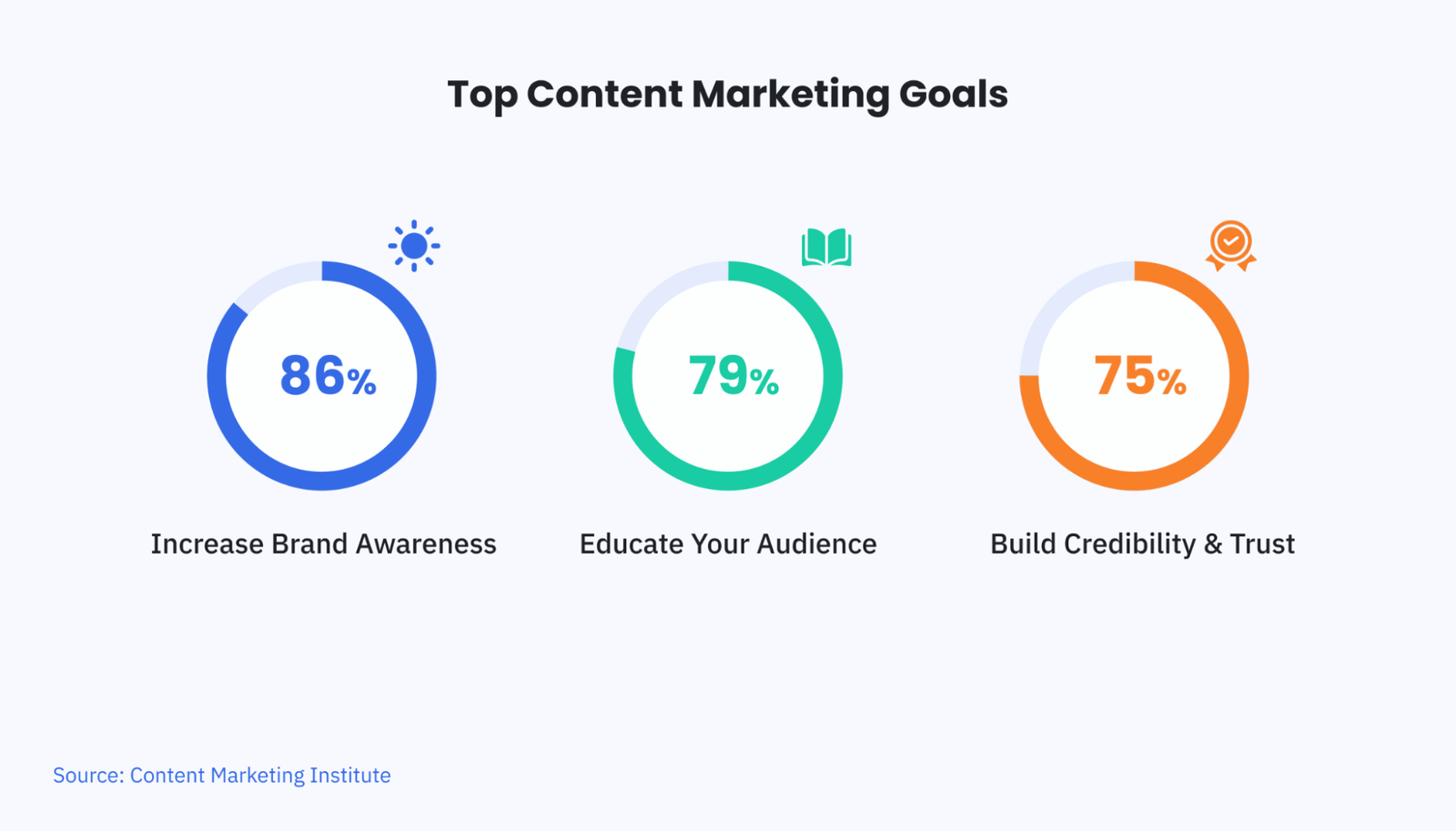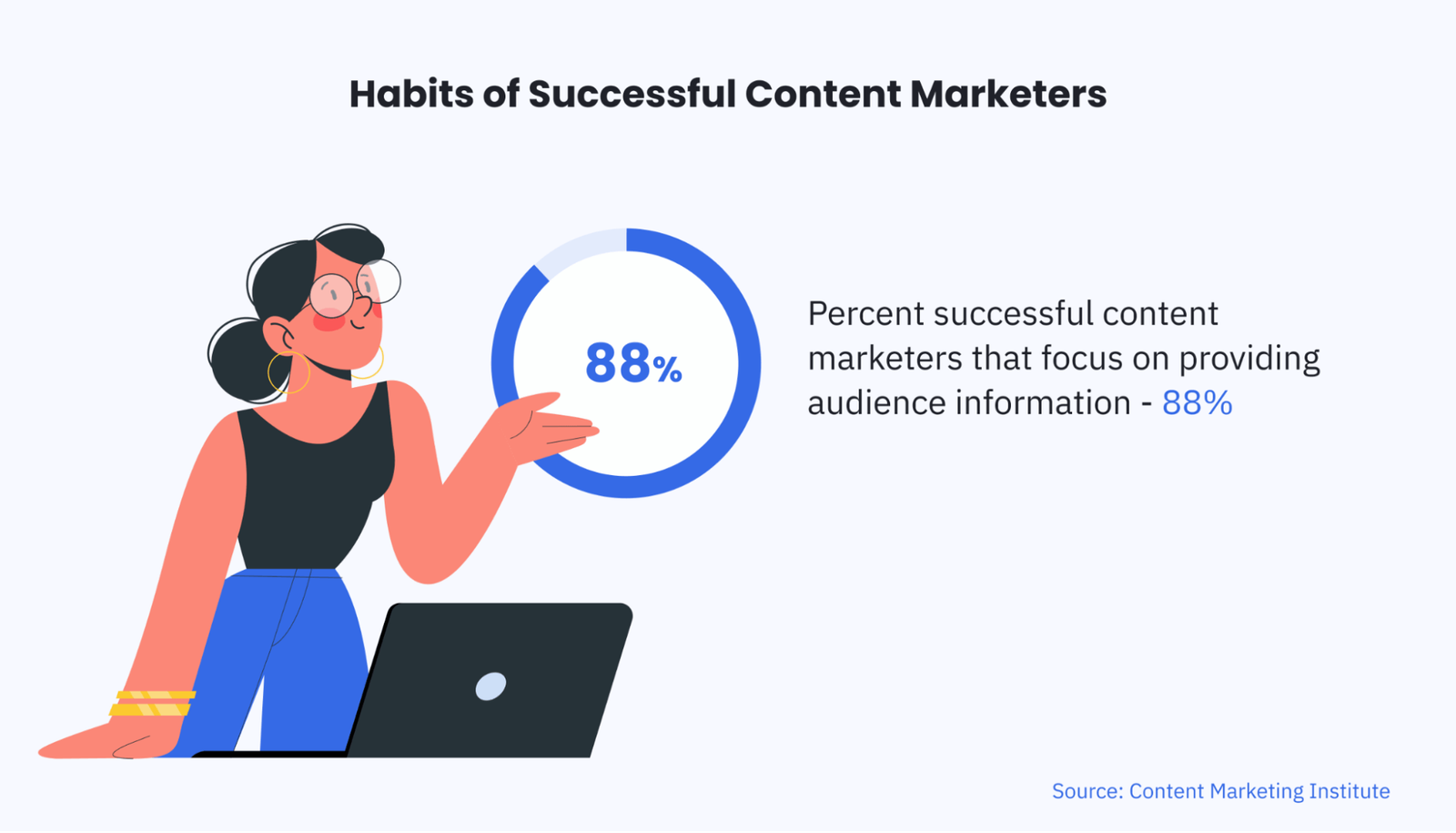The field of digital marketing is ever-expanding, so it’s time to take a look at some of the most important digital marketing statistics and trends that will impact your business.
While some concepts, like creating useful, trustworthy content for your audience, haven’t gone anywhere, there are a few things to look out for as you plan for the future of your business.
In this article, we’ll give you the latest on content marketing, social media, SEO, and marketing automation to make your campaigns run more efficiently.
Digital marketing benefits and ROI statistics
Digital marketing offers new opportunities for your business. Since it’s highly measurable and adaptable, you can customize your digital marketing efforts to meet your business goals.
- 86% of marketers increased brand awareness by using one or more digital marketing channels. (Content Marketing Institute, 2020)
- 79% of marketers educated their audience via digital marketing. (Content Marketing Institute, 2020)
- 75% of marketers increased their company’s credibility and trust with digital marketing tactics. (Content Marketing Institute, 2020)

- 75% of agency marketers said that email marketing has excellent or good ROI. (Statista, 2019)
- 74% of marketers said that SEO has excellent or good ROI. (Statista, 2019)
- 73% of marketers said that content marketing has excellent or good ROI. (Statista, 2019)
- 61% of marketers said that paid search has excellent or good ROI. (Statista, 2019)
- 56% of marketers said that social media marketing has excellent or good ROI. (Statista, 2019)
Although some digital marketing channels are more effective than others, the beauty of a digital marketing strategy is that you can build a combination of channels and tactics that works for your audience.
Content marketing stats
Content marketing supports other digital marketing strategies such as SEO and email marketing. By creating high-quality, informative content, you’ll build a strong foundation for education and inspiring your audience that pays off big time.
- 59% of B2C marketers increased their content marketing budgets in 2020 compared to 2019. (Statista, 2020)
- 83% of B2C content marketers use blog posts or short articles in their strategy. (Statista, 2020)
- 74% of B2C marketers said they used email newsletters for content marketing. (Statista, 2020)
- 38% of B2B company blogs publish content to educate their audience. (Backlinko, 2021)
- 86% of B2B content marketers believe their audience sees them as trusted sources in their niche. (Content Marketing Institute, 2020)
- 85% of B2B content marketers use email marketing software to assist with content marketing. (Content Marketing Institute, 2020)
- 88% of the most successful content marketers prioritize audience information over sales messages, compared to 50% of the least successful content marketers. (Content Marketing Institute, 2020)

There are plenty of ways to distribute content to your audience. What matters most is creating a content strategy that builds trust and helps your audience make a smart purchasing decision.
Video marketing stats
Video is a rapidly growing segment of content marketing. A video marketing strategy is more resource-intensive than developing a blog or email newsletter, but it comes with its own unique benefits and approaches.
- Video marketing use has increased by 41% since 2016. (Wyzowl, 2020)
- 87% of video marketers used YouTube last year, making it the most widely used video marketing platform for the seventh year in a row. (Wyzowl, 2020)
- 96% of consumers have watched a video about a product or service. (Wyzowl, 2020)
- 84% of consumers purchased a product because they watched a marketing video. (Wyzowl, 2020)
- 78% of video marketers say video has directly helped increase sales (Wyzowl, 2020)
Video marketing is a powerful tool for your digital marketing strategy, helping you reach new segments of your target audience.
SEO statistics
SEO, or search engine optimization, encompasses content creation, authority and link building, and technical elements to help your company website rank on Google and other search engines. It’s a complex digital marketing channel, so use these organic search statistics to keep track of current trends:
- Small businesses spent $26.87 billion on SEO in 2020. (Statista, 2020)
- Google makes up 87.7% of the global search engine share, followed by Bing at 5.56%. (Statista, 2021)

- B2B blogs with educational content get 52% more organic traffic than B2B blogs with company-focused content. (Backlinko, 2021)
- If you’re looking to build backlinks, longform content gets 77.2% more links than short articles. (Backlinko, 2019)
- 40% of online search queries contain two keywords. (Statista, 2020)
- 14.1% of all Google searches are in the form of a question. (Backlinko, 2020)
- Only 2.4% of all Google search results have no SERP features, like People Also Ask questions, an image carousel, or a knowledge panel. (Backlinko, 2020)
SEO works best when you inform your audience, not sell to them. By understanding keywords and search terms, you can tailor your content to both your industry and audience for maximum impact.
Social media stats
When it comes to social media marketing, it’s easy to think you need to be on every social media platform to reach every possible new customer.
But just because a social media platform exists doesn’t necessarily mean you must have a presence there. Instead, you’ll need to carefully consider which social media platforms work best for your audience, industry, and marketing goals.
- Roughly 80% of online consumers have made a purchase from social media ads. (Statista, 2019)
- 73% of social media marketers set a goal of acquiring new customers. (Hootsuite, 2021)
- 64% of social media marketers intend to increase brand awareness. (Hootsuite, 2021)
- 45% of social media marketers are looking to drive conversions. (Hootsuite, 2021)

- Facebook is the most popular social media platform, used by 94% of B2B and B2C marketers. (Statista, 2021)
- 76% of marketers use Instagram (Statista, 2021)
- 67% of marketers worldwide say they’ll increase Instagram use in the future (Statista, 2021)
- 95% of B2B marketers used LinkedIn in 2020, making it the top B2B social media channel. (Content Marketing Institute, 2020)
- To maximize social shares, aim for your content to be between 1,000 and 2,000 words long. (Backlinko, 2019)
Social media marketing typically focuses on top of funnel marketing activities, such as brand awareness. It’s an important component of retargeting campaigns or any multichannel digital strategy.
Email marketing stats
Email marketing remains a powerful tool for reaching your consumers directly, especially in B2B companies.
- 85% of B2B companies use email marketing software to distribute and manage their content. (Content Marketing Institute, 2020)
- Email marketing has an average conversion rate of 3.71%. (Optinmonster, 2020)
- 48% of B2B digital marketing professionals said email marketing was highly effective in driving conversions. (Statista, 2019)
For more insights into email marketing, check out our roundup of the top email marketing statistics for 2021.
Digital marketing automation stats
Let’s pivot to look at marketing automation. This technique helps you and your team reduce manual tasks and improves your digital marketing strategy’s accuracy, personalization, and more.
- 75% of businesses currently use marketing automation tools. (Social Media Today, 2019)

- 17.4% of marketers said marketing automation was the single most effective digital marketing technique — more effective than social media, CRO, and SEO. (Statista, 2020)
- 48% of marketers use marketing automation to create personalized customer experiences. (House of Marketing, 2019)
- 67% of marketers use email marketing solutions to execute personalization in their campaigns (Statista, 2020)
- Despite shrinking overall marketing budgets, 26.6% of CMOs say they’ll increase their budget for marketing technology such as automation tools. (Gartner, 2021)
Marketing automation is an increasingly important element of digital marketing across industries. Get started with your automation efforts now to get ahead of your competitors.
Lead generation and nurturing stats
The right lead generation and nurturing strategy make a huge difference in the quantity and quality of your leads. You’ll need to find the right channels and use the right tactics to get qualified leads that ultimately become sales.
- 50% of B2B marketers say email is the most effective channel for lead generation, followed closely by search engine optimization. (Statista, 2019)
- 83% of B2B content marketers say they’ve successfully used content marketing to nurture leads and subscribers. (Content Marketing Institute, 2020).
- 60% of B2B marketers say they waste time and resources addressing lead generation challenges like creating engaging content and gathering accurate data. (Wpromote, 2021)
- 49% of marketers believe their lead nurturing programs need improvement. (Demand Gen Report, 2020)
- 35% of marketers reach out to their leads weekly, with 22% contacting them every three days. (Demand Gen Report, 2020)
Like all elements of an effective digital marketing strategy, you’ll have to devise your lead generation approach based on your audience’s needs and wants. Then, you can nurture them throughout the sales funnel until a lead becomes a customer.
Ecommerce marketing stats
Ecommerce marketing requires a different approach than lead generation, regardless of whether you’re a B2B or B2C company. Tactics like influencer marketing and email offers and discounts are more effective.
- Ecommerce sales are expected to make up 15% of all retail sales in 2021. (Statista, 2020)
- 52% of European ecommerce retailers say influencer marketing offers the best ROI for their business, but they expect that to shift to social media advertising by 2030. (Statista, 2020)
- 75% of ecommerce stores are working or plan to work with social media influencers in 2020 and beyond. (Statista, 2020)
- 76% of ecommerce companies plan to expand or improve their personalization technology. (Statista, 2020)
- 72% of ecommerce marketers use Facebook for digital marketing. (Kantar, 2021)
- 41% of consumers say the product detail page (PDP) was the most important touchpoint during their customer journey. (Kantar, 2021)
- Only 37% of marketers optimize their PDPs for SEO. (Kantar, 2021)
Social media plays an important role in ecommerce marketing, especially in the B2B space. Pay close attention to social media trends and pivot your strategy to accommodate those when they impact key audience segments.
All Your Statistics In One Place
Mobile marketing stats
It’s no secret we spend a ton of time on our phones. So the question becomes: how do you take advantage of that as a marketer?
As mobile device use rises and mobile commerce becomes a bigger slice of the retail pie, there are plenty of opportunities for your business to take advantage of the mobile boom.
- On average, companies spend 18.5% of their marketing budget on mobile marketing efforts. (Statista, 2021)
- Consumers spend about 4.2 hours per day on mobile devices, up 20% from last year. (App Annie, 2021)

- Mobile commerce (m-commerce) grew by more than 30% worldwide throughout 2020. (App Annie, 2021)
- Use of business communication apps grew 275% in 2020, a habit that may build a bridge between B2B and B2C consumer habits. (App Annie, 2021)
- 77% of mobile internet users found targeted mobile ads annoying rather than helpful. (Statista, 2019)
Mobile marketing is still growing and evolving. Keep an eye out for new trends, so you’re ready to hit the ground running.
Love statistics? Here are some other great resources
Boost your strategy with these digital marketing stats
Digital marketing is an increasingly critical element for the success of any business.
But digital marketing is always changing. Use these statistics to help you craft an up-to-date strategy that helps your business increase leads, sales, and ultimately revenue.
For more resources, check out our digital marketing articles on the ActiveCampaign blog.








